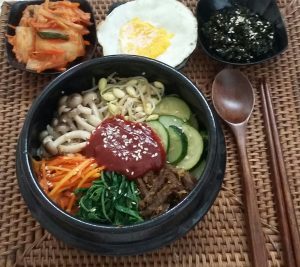What pops into your head first when you think of Korean food (K-Food)?
Maybe kimchi, kimbap, bulgogi, tteokbokki, ramyeon or bibimbap. For me, I love all of them. My passion for K-food started to grow when I deeply fell in love with K-dramas and variety shows. They often show Korean cuisines which are colorful and made from fresh ingredients. Did you know that Korean food is also one of the healthiest cuisines in the world? Most dinners have a maximum calorie intake of less than 600 calories. Compare that to eating a pizza that has well over 1,000 calories and it’s not hard to see why Koreans aren’t known for being obese.
One of the K-food that I cooked recently is Bibimbap, mixed rice with meat and assorted vegetables (Bibim [비빔] = Mixed ; bap [밥] = Steamed rice). A bowl is loaded with rice at the bottom, and topped with a selection of goodies that are laid out to look like jewels floating on the white rice bed. Sliced beef, a selection of sautéed vegetables called namul, and several sauces, usually soy sauce, sesame oil and gochujang (chili pepper paste adding a spicy kick). An egg (raw or cooked) is added on top just prior to serving.
The beauty of Bibimbap is in the perfect harmony between various tastes and nutrition that results from mixing various ingredients into one bowl. By eating one bowl of Bibimbap, you can take in carbohydrate (rice), protein (beef and egg), vitamins and minerals (various vegetables), and of course fat (sesame oil). In addition, most of the fat in Bibimbap is vegetable fat.
THE ORIGINS OF KOREAN BIBIMBAP RECIPE
Bibimbap is only about a century old, but it derives from Goldongban, a dish involving the same concept (a bowl of rice with vegetables, meat and sauce mixed in), which is far older, emerging sometime during the Joseon Period (14th – 16th centuries). Goldongban had a ritualistic, and potluck, component to it. It was eaten on the eve of the lunar new year, allowing people to clear out their pantries at the year’s end, throwing whatever was left over into their rice bowls, tossing it together, and considering it dinner.
I’m going to share the recipe for my version of Bibimbap.
Ingredients: (Serves 4)
 5 cups cooked rice
5 cups cooked rice
100 g soy bean sprouts
1 large carrot
1 large zucchini
100 g shimeji mushroom (or shitake mushroom)
100 g spinach
200 g beef
4 eggs
Korean seasoned seaweed
4 tablespoon gochujang (Korean red pepper paste)
3 tablespoon sesame oil
1 tablespoon soy sauce
1 tablespoon sugar
2 tsp minced garlic
2 tablespoon roasted sesame seeds
Directions:
Slice the beef thinly and mix it with minced garlic, soy sauce, 1 tbsp sesame oil and marinate it for 30 minutes.
Stir fry the marinated beef with 1 tbsp cooking oil.
Blanch the spinach and soy bean sprouts, squeeze to remove the excess water.
Peel and julienne the carrot, stir fry with 1 tsp sesame oil and salt.
Slice the zucchini thinly, stir fry with 1 tsp sesame oil and salt.
Rinse the mushroom, stir fry with 1 tsp sesame oil and salt.
Make fried eggs (sunny side up).
For the sauce: Mix gochujang, 1 tbsp sesame oil, 1 tbsp sugar, 1 tbsp roasted sesame seeds
Serving
Put the rice into a bowl and arrange the meat and the assorted vegetables on top. Add the bibimbap sauce, fried egg and seasoned seaweed.
Mix it and enjoy!

More Stories
中秋节活动 Chinese Middle Autumn Festival 22-23
BBS KJS Opinion : By BSP Scholars (Round 2)
FOODS YOU HAVE TO TRY